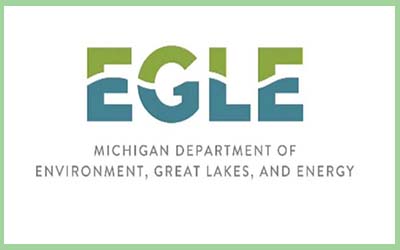FOR IMMEDIATE RELEASE
May 30, 2024
Jeff Johnston, EGLE Public Information Officer, JohnstonJ14@Michigan.gov, 517-231-9304
Trevor Layton, SEMCOG Communications Manager, layton@semcog.org, 313-580-6195
Great Lakes and Fresh Water Week, June 1-9, celebrates water-wellness connection
EGLE and partners focus on how Michiganders engage with the water wonderland around us
Whether we’re drinking from the tap or drinking in a lake view, water and wellness go hand in hand in Michigan.
That’s the message of this year’s Michigan Great Lakes and Fresh Water Week (GLFWW), Saturday, June 1-Sunday, June 9. The annual dedication by Michigan’s Department of Environment, Great Lakes, and Energy (EGLE) and partners will focus on events and resources related to physical, mental, and spiritual wellness as a result of connecting with water, as well as continuing to dive into enjoyment, recreation, appreciation, stewardship, and protection of the Great Lakes, their environment, and their communities.
“Michigan is home to 21% of the world’s fresh surface water and defined by the Great Lakes,” said Governor Gretchen Whitmer. “During Great Lakes and Fresh Water Week, let’s recommit ourselves to protecting our waters, which are critical to our state’s economy and the future of our planet and people. Together, we can be good stewards of our extraordinary natural resources and build a brighter future for our kids.”
Governor Whitmer in 2020 commissioned the MI Healthy Climate Plan as a broad road map to a prosperous, clean energy future for Michigan. The plan includes a provision, dubbed “30 by 30,” to protect 30% of state land and water by 2030 to preserve recreational access and biodiversity, as well as to naturally absorb greenhouse gas emissions.
Michigan boasts more than 3,200 miles of coastline along four Great Lakes, 11,000 inland lakes and ponds, 36,000 miles of rivers and streams, and enough groundwater to fill Lake Michigan over again. More than 30 million people in the U.S. and Canada rely on the Great Lakes for their drinking water.
EGLE and its Office of the Great Lakes (OGL) partner with the (DNR) and the Southeast Michigan Council of Governments (SEMCOG) to sponsor GLFWW.
The week will highlight ways everyone can engage with Michigan waters for their well-being: through responsible exploration and enjoyment, learning about freshwater systems and how our actions affect them, and prepping for rewarding careers in Michigan’s water-centered blue economy.
“I know there are so many Michiganders who, like me, find fulfillment in the beauty and bounty of our lakes, rivers, and streams and appreciate a week to reflect on their value in our lives,” EGLE Director Phil Roos said. “When we bike, walk, and canoe on and along Michigan waters, we understand that these great resources bring not only great responsibilities but great rewards.”
“The Great Lakes and fresh water are tremendous and inseparable natural attributes that define Michigan,” DNR Director Scott Bowen said. “There are countless benefits realized every day from these precious resources. The need to care responsibly for them and conserve them cannot be overstated.”
“There is only One Water; there is no substitute for the enrichment, enjoyment, and tranquility that it brings to our lives,” SEMCOG Executive Director Amy O’Leary said. “SEMCOG is proud to partner with the Office of the Great Lakes this Great Lakes and Freshwater Week to celebrate the wellness benefits of access to fresh water in Southeast Michigan and across the whole state. We also celebrate and honor all the water champions, whose stewardship is making a huge difference in the health and wellness of our lakes, rivers, and streams.”
This year’s theme encourages Michiganders to consider what the Great Lakes and fresh waters mean to them personally and for their mental and physical wellness. EGLE invites visitors to use the hashtag #MIGreatLakesWeek to share photos and reflections on social media, or to share them on EGLE’s Facebook page.
Michiganders also may go fishing or take to the trails for free Saturday and Sunday, June 8-9. On these two days, the DNR will waive the need for a fishing license, off-road vehicle license, trail permit, and the Recreation Passport requirement for admission to Michigan state parks and boating access sites.
Reading for pleasure and knowledge is another way to enjoy a water-wellness connection, and local libraries offer plenty of “beach reads” (or anywhere reads) focused on Michigan waters.
The Library of the Great Lakes and partners have selected two books – “The Water Walker” by Joanne Robertson for children and “The Best Part of Us” by Sally Cole-Misch for adults – as choices for this year’s first-ever Great Lakes, Great Read program.
Meanwhile, “Adventure Begins at Your Library!™” where written lake adventures abound for readers of all ages. The Library of Michigan’s searchable Read Michigan BiblioBoard has a list of 113 eBooks related to the Great Lakes – all part of the state library’s Michigan Notable Books selections. The library suggests hashtags #MiLibraries and #MiSummerReading for social posts about your reading lists.
And there’s always EGLE’s inviting and information-packed 2023 Michigan State of the Great Lakes Report to curl up with.
Details about GLFWW are available on the OGL’s Stewarding the Great Lakes webpage, including links to local events, videos, educational resources on topics such as invasive species identification and proper disposal of old medications, and information on how to volunteer with the Michigan Clean Water Corps. Among the many ways to participate:
- Tap into SEMCOG’s One Water campaign, developed in partnership with the Great Lakes Water Authority to build public awareness and mutual shared responsibility for water resources. The campaign runs June 1-9.
- Virtually attend a water webinar:
- Join an EGLE webinar at 1 p.m. Tuesday, June 4, titled “Tribal Wisdom on Nibi and Ecosystems: Manoomin and the Circle of Life,” to learn about the importance of water (Nibi) and wild rice (Manoomin), which hold cultural and ecological significance for the Ojibwe and Anishinaabe tribes.
- Emily Finnell, Great Lakes senior advisor and strategist with the Office of the Great Lakes, will moderate a webinar from 11:30 a.m.-1 p.m. Thursday, June 6, titled “Fostering Connections to Michigan’s Water Wonderland for Wellness and Stewardship.” Finnell will be joined by panelists Mike Shoreman, consultant, keynote speaker, author, and filmmaker; psychologist Dr. Michael Comer; Dr. Debra Pinals, Michigan Department of Health and Human Services medical director for behavioral health and forensic programs; and Tim Novak, trails section chief with the Parks and Recreation Division of the DNR. Participants will discuss how time spent on and near water can improve wellness, as well as available resources and efforts to improve mental health and increase access to the Great Lakes and Michigan’s lakes, rivers, and streams for people of all abilities.
- Watch a recorded SEMCOG webinar titled “Utilizing the One Water Campaign in Your Community,” which was held May 22. The webinar provides valuable insights into how local governments can educate residents about Southeast Michigan’s water resources through the One Water campaign. Find the link on SEMCOG’s One Water page.
- Check out more water-related webinars – past and future – on EGLE’s Webinar Series and Past Events and Recorded Webinars webpages.
- Engage with EGLE, DNR, and SEMCOG on social media for news, information, and insights into water-wellness connections (#MIGreatLakesWeek).
- Join in exploring more about water resources and quality by checking out SEMCOG’s social media pages daily during GLFWW for water-related trivia.
- Teachers, explore the From Students to Stewards toolkit for place-based educational resources that will instill a desire to learn about water resources and protect our lakes and streams.
- Public officials, check the Michigan Municipal League Foundation’s MI Water Navigator website as a guide to navigating infrastructure funding opportunities.
|







